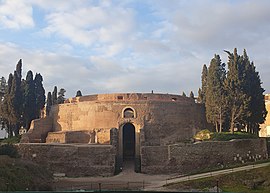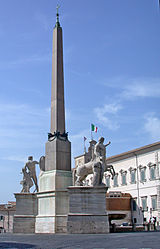|
Mausoleum of Augustus
The Mausoleum of Augustus (Latin: Mausoleum Augusti; Italian: Mausoleo di Augusto) is a large tomb built by the Roman Emperor Augustus in 28 BC on the Campus Martius in Rome, Italy. The mausoleum is located on the Piazza Augusto Imperatore, near the corner with Via di Ripetta as it runs along the Tiber. The grounds cover an area equivalent to a few city blocks nestled between the church of San Carlo al Corso and the Museum of the Ara Pacis. After being closed for fourteen years to perform restoration work, the mausoleum was reopened to the public in March 2021.[1][2][3] DescriptionThe mausoleum was circular in plan, consisting of several concentric rings of earth and brick, faced with travertine on the exterior, and planted with cypresses on the top tier. The whole structure was capped (possibly, as reconstructions are unsure at best) by a conical roof and a huge bronze statue of Augustus. Vaults held up the roof and opened up the burial spaces below. Twin pink granite obelisks flanked the arched entryway; these have been removed; one now stands at the Piazza dell'Esquilino (on the north-west side of the Basilica of Santa Maria Maggiore) and the other at the Quirinal fountain. The completed mausoleum measured 90 m (295 ft) in diameter by 42 m (137 ft) in height. A corridor ran from the entryway into the heart of the mausoleum, where there was a chamber with three niches to hold the golden urns enshrining the ashes of the Imperial Family. Two pillars flanking the entrance were mounted with bronze plaques inscribed with the Res Gestae Divi Augusti, the document describing Augustus' accomplishments and victories.[4] Surrounding the mausoleum was landscaped parkland akin to modern public parks, affording a place of retreat at the heart of Rome's heavily urbanized Campus Martius.
HistoryAncientThe mausoleum was one of the first projects initiated by Augustus in the city of Rome following his victory at the Battle of Actium in 31 BC. The traditional story is that in AD 410, during the sack of Rome by Alaric, the pillaging Visigoths rifled the vaults, stole the urns and scattered the ashes, without damaging the structure of the building.[5] Platner and Ashby, however, posited that "The story of its plundering by Alaric in 410 has no historical foundation, and we know nothing of its destruction".[6] MedievalBy the end of the 10th century, the mausoleum had become largely buried under earth and overgrown with trees, to the point where it was referred to as the Mons Augustus. A legend of the time referred to a supposed decree by Augustus who ordered that a basketful of earth from every province of the empire was to be thrown upon his tomb, so that he could rest on the soil of the whole world over which he ruled. Atop the Mausoleum stood a chapel built to the Archangel Michael, while alongside was the Church of Santa Maria (or perhaps Martina) in Augusto (later transformed into San Giacomo degli Incurabili).[7] By the 12th century, the tumulus was fortified as a castle – as was the mausoleum of Hadrian, which was turned into the Castel Sant'Angelo – and occupied by the Colonna family. After the disastrous defeat of the Commune of Rome at the hands of the Count of Tusculum in 1167, the Colonna were disgraced and banished, and their fortification in the Campo was dismantled. Throughout the Renaissance it passed through the ownership of several major Roman families, who used it as a garden. ModernIn the early 20th century, the interior of the Mausoleum was used as a concert hall called the Augusteo,[6] until Benito Mussolini ordered it closed in the 1930s and restored it to the status of an archaeological site. The restoration of the Mausoleum of Augustus to a place of prominence featured in Mussolini's ambitious reordering of the city of Rome which strove to connect the aspirations of Italian Fascism with the former glories of the Roman Empire. Mussolini viewed himself especially connected to the achievements of Augustus, seeing himself as a 'reborn Augustus' ready to usher in a new age of Italian dominance. This restoration occurred in 1937, on the 2000th anniversary of Augustus' birth.[8] Restoration
 The neglect of the mausoleum—closed to the public, overgrown with vegetation, and used as a dumping ground for litter—attracted criticism, especially after the opening of the Ara Pacis museum across the street in 2006.[2] A plan to restore the mausoleum in time for the 2000th anniversary of Augustus's death in 2014 failed due to funding shortfalls.[9] In January 2017, Italian authorities announced a €6 million grant from Telecom Italia for a comprehensive restoration of the Mausoleum of Augustus, allowing it to open to the public for the first time since the 1970s. The Mausoleum was slated for a full restoration incorporating a multimedia exhibition of modern and ancient Rome projected on the interior walls of the structure to be completed by April 2019.[3] The schedule was not met, shifting the deadline to early 2021.[10] The costs expanded to €11 million, although this was partially offset by additional grants from Telecom Italia's successor Gruppo TIM.[11] The mausoleum opened to visitors in 2021, although additional restoration—including the central cylinder housing Augustus' burial chamber—was left undone, scheduled for completion in 2022.[12] The projected date for the mausoleum's reopening has been varied, and currently the mausoleum has been temporarily closed since June 6th, 2022 to allow for redevelopment of Piazza Augusto Imperatore to progress.[13] Burials Included among those whose remains were laid inside the mausoleum before the death of Augustus were:
After the death of Augustus, the mausoleum hosted the remains of:
LegacyThe Roman poet Martial wrote about the building: See also
References
External links
|
|||||||||||||||||||||||







